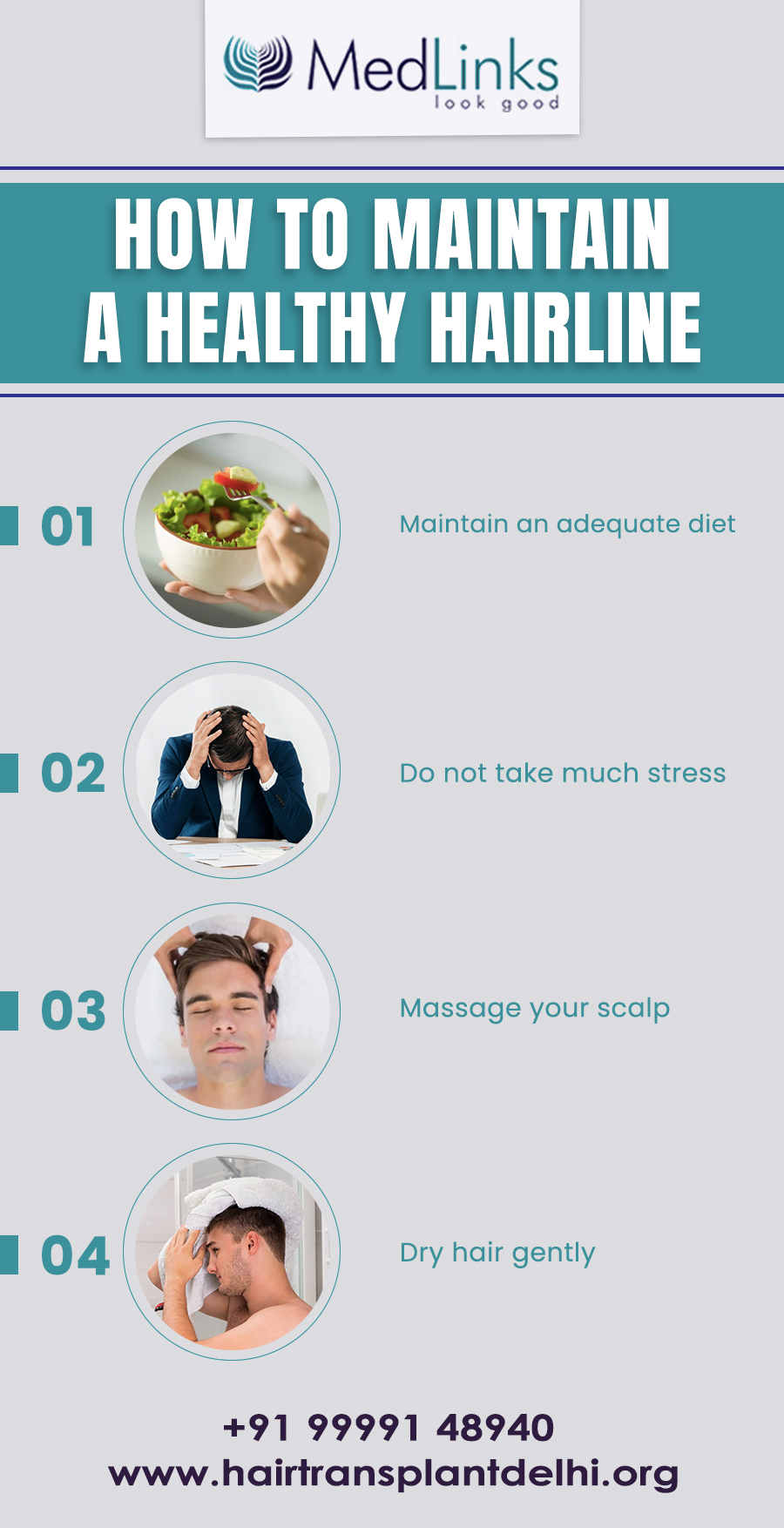- Home
- About Us
- Hair Transplant
- Hair Loss
- Medical Treatment
- Patients Gallery
- Our Patients
- Blog
- Contact Us
- Hair Transplant Cost
- Book an Appointment
- Brochure

With advancing medical technologies, more and more people are now aware of cosmetic procedures, especially hair restorative techniques. However, no one wants to give away the fact that they got any cosmetic procedures done. And, one of the biggest give away of it is a poorly done hairline.
It is crucial for both patient and surgeon that a natural hairline restoration is ensured to get a more defined look. Here, we will discuss everything there is to know about creating a natural hairline and the steps involved in the same.
Feel free to skip ahead if one topic catches your eye
Creating a natural hairline is the primary element of a successful hair transplant in delhi. It helps to restore the tufted look on the scalp, but it also conceals that one has undergone any hair restorative procedure.
A hair transplant procedure’s success not just depends on the volume of hair after the transplant; it is also defined by how inconspicuous everything looks after the surgery. The surgeons select individual grafts or follicles of hair judiciously and place them across the patient’s natural hairline to restore their look.
When it comes to the natural hairline in people, there is nothing standard or universal. There are a few types of hairline, and they will vary from person to person. Some people have a lower hairline covering most of their forehead, while some have a high hairline, resulting in a broader forehead.
Every hairline is normal until it starts receding. Receding hairline around the temples is very common in men and also a primary sign of male-pattern baldness. However, the receding hairline isn’t visible in a day. It is a gradual process and eventually starts becoming more visible.
While baldness and receding hairline are pretty standard in men, the same thing happens with women too.
Following are some of the types of natural hairline in individuals:
Low hairline - This type of hairline starts closer to the eyebrows and covers half of the forehead, giving a more defined and smaller look to the shape of a face. Receding hairline in people with a low hairline is significantly less evident.
Middle hairline - Often termed as the “normal” hairline, It is the one that starts from the upper-middle portion of the forehead and even results in an M-shaped receding hairline which becomes noticeable over time.
Straight hairline - Unlike the other hairlines this follows the head’s shape, and a straight hairline makes a perpendicular shape along with the head’s side which is often very common in men.
High hairline - A high hairline is the one that results in the most evident receding hairline. This type of hairline starts from the crown of the head and commonly a result of genetic predisposition.
Triangular hairline - A triangular hairline generally starts from the sides and the lower region of the temples & raises to the head’s center.
Cowlick - This is one of the unique types of hairlines wherein a few tufts of hair growth are different from the hair growth’s normal direction on the scalp.
However, according to the hair transplantation procedure, There are three different parts to natural hairline designing:
Transition Hairline - This includes the first 0.5 to 1 cm of the hairline and is one of the most crucial parts of hairline designing. Including micro irregularity in this zone is important to instill a more natural look to the hairline. In this zone, multiple V-patterns are drawn to provide a guide to the surgeon to implant the hair grafts. Surgeons generally implant individual hair follicles in this zone.
Define Zone - This is located right behind the transition zone and covers 2-3 cms surface area, where grafts containing 2-3 hairs are implanted.
Frontal Tuft Area - This part is located in the central position of the defined zone and is the region where the maximum of hair follicles are implanted for a fuller and more voluminous look.

If you are wondering how to get a perfect hairline, it involves various factors. From the angle to the successful implants of the hair follicles, there are a few essential elements that play a critical role:
The angle of the hairline is the degree of elevation of the hair that grows from the scalp. The direction, on the other hand, is how the hair growth points from the scalp. There is a difference between the frontal and the temporal hairline.
The hair at the frontal hairline generally comes out at 10-15 degree angles while hairs growing from the temporal hairline point towards the ear and give a flat look compared to the frontal hairline’s growth.
For the frontotemporal angle, the hair transplant surgeon changes the hair’s natural direction from pointing anteriorly to inferiorly. The rest of the hairline is restored then and matched according to the patient’s remaining hairline design.
After defining the hair transplant’s angle and direction, the surgeon then focuses on drawing the hairline’s anterior border, especially for the patients who don’t want their hairline to be too low.
The critical factors involved in drawing the ideal anterior border include:
Hair transplantation is an extensive process that involves rigorous consultation with the surgeon followed by the procedure. Despite the type of hair transplant procedure the patient is undergoing - be it FUE or FUT hair transplantation, the basic procedure or the overview is pretty similar in both cases.
Here’s what a surgeon does during the hair transplant procedure:
Draw the hairline design - The first and most crucial step is to draw the patient’s hairline design according to their expectations. The surgeon will ask you about your expected results right during the first consultation. Once that is done, the surgeon then draws the hairline based on the patient’s need and natural hairline.
Marking incisions - Once the initial hairline design is drawn around the forehead, the surgeon then moves onto making the marks around the donor and recipient sites to enable easier extraction and implants of the healthy hair follicles.
Making an initial framework for the transition zone - As mentioned before, the transition zone includes the new hairline’s first centimeter. So, paying close attention to this zone is important to ensure a natural-looking hairline in the patients. An initial framework with ideal markings helps to ensure correct implantation with right angles and direction of the hair regrowth.
Placing the grafts - Following extraction of the hair follicles from the donor site, the surgeon prepares them into grafts of 2-3 follicles, then implants them into the recipient site. Placing the grafts along the hair’s natural direction is important for higher success rates also avoiding the risks of creating a cowlick hairline.
Fine-tune the hairline - Once the grafts are placed after the initial round of implants, the surgeon then comes back to assess the hairline region to ensure it has been filled according to the markings and framework for a natural regrowth after the patient undergoes the hair transplant for receding hairline.
Drawing and designing the hairline are the most crucial parts of a hair transplant procedure. You need to consult professionals with years of hands-on experience in hair transplantation for higher satisfaction rates and a more natural look.
At Medlinks, you are assured of getting the best hair transplant treatments from our team of highly qualified and experienced surgeons in creating a perfect and natural hairline for the patients.

Dr. Gaurang Krishna

Copyright © 2025 Medlinks. All Rights Reserved.
Disclaimer:The content published on this website(hairtransplantdelhi.org) is meant to spread awareness and educate the concerned patients regarding baldness and hair transplants as well as the treatment options available for baldness and hair transplant treatment in Delhi India. Any information on the website shall not be regarded as a prescription from a professional dermatologist. We recommend visiting a dermatologist in person for the right diagnosis and the treatment for any hair issues. We do not guarantee specific results as the treatments and the results vary from person to person.